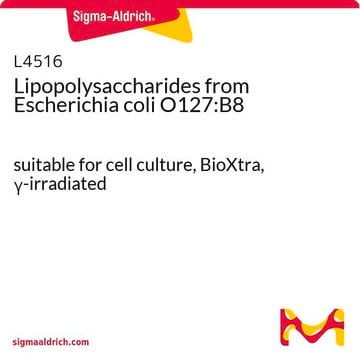L5418
Lipopolysaccharides from Escherichia coli O55:B5
Ready Made solution, 1 mg/mL
Synonym(s):
LPS
Sign Into View Organizational & Contract Pricing
All Photos(1)
About This Item
Recommended Products
biological source
Escherichia coli (O55:B5)
Quality Level
form
aqueous solution
concentration
1 mg/mL
color
white to faint yellow
solubility
water: 4.90-5.10 mg/mL, faintly hazy to hazy, colorless to faintly yellow
shipped in
wet ice
storage temp.
2-8°C
Looking for similar products? Visit Product Comparison Guide
General description
This product is a 0.2 um filtered aqueous solution containing 1 mg/mL of lipopolysaccharides (LPS) from E. coli serotype O55:B5. The source strain is CDC 1644-70. This LPS serotype has been used in studies of septic shock and to induce myocarditis.
Application
Lipopolysaccharides (LPSs) are characteristic components of the cell wall of Gram-negative bacteria. LPS and its lipid A moiety stimulate cells of the innate immune system by the Toll-like receptor 4 (TLR4), a member of the Toll-like receptor protein family, which recognizes common pathogen-associated molecular-patterns (PAMPs).
Biochem/physiol Actions
Lipopolysaccharides (LPS) are localized in the outer layer of the membrane and are, in noncapsulated strains, exposed on the cell surface. They contribute to the integrity of the outer membrane, and protect the cell against the action of bile salts and lipophilic antibiotics.
Preparation Note
The LPS used to prepare the solution have been phenol-extracted and chromatographically purified by gel filtration. Lipopolysaccharides prepared by phenol extraction contain up to 60% RNA and less than 1% protein. Subsequent purification by gel filtration chromatography removes much of protein present in the phenol-extracted LPS, but leaves a product that still contains 10-20% nucleic acids. Further purification using ion exchange chromatography yields an LPS product which contains <1% protein and <1% RNA.
Other Notes
To gain a comprehensive understanding of our extensive range of Lipopolysaccharides for your research, we encourage you to visit our Carbohydrates Category page.
related product
Product No.
Description
Pricing
Storage Class Code
12 - Non Combustible Liquids
WGK
WGK 1
Flash Point(F)
Not applicable
Flash Point(C)
Not applicable
Personal Protective Equipment
dust mask type N95 (US), Eyeshields, Gloves
Certificates of Analysis (COA)
Search for Certificates of Analysis (COA) by entering the products Lot/Batch Number. Lot and Batch Numbers can be found on a product’s label following the words ‘Lot’ or ‘Batch’.
Already Own This Product?
Find documentation for the products that you have recently purchased in the Document Library.
Customers Also Viewed
Eric Danilo Pauls Sotelo et al.
Veterinary sciences, 7(2) (2020-05-06)
Several studies in human and equine medicine have produced controversial results regarding the role of dimethylsulfoxide (DMSO) as a therapeutic agent. This study aimed to evaluate the effect of joint lavage with different DMSO concentrations on biomarkers of synovial fluid
Janny C de Grauw et al.
Arthritis research & therapy, 11(2), R35-R35 (2009-03-11)
Inflammation is an important feature of many joint diseases, and levels of cartilage biomarkers measured in synovial fluid may be influenced by local inflammatory status. Little is known about the magnitude and time course of inflammation-induced changes in cartilage tissue
Lauren E Adams et al.
Antioxidants (Basel, Switzerland), 10(3) (2021-04-04)
Therapeutic hypothermia does not improve outcomes in neonatal hypoxia ischemia (HI) complicated by perinatal infection, due to well-described, pre-existing oxidative stress and neuroinflammation that shorten the therapeutic window. For effective neuroprotection post-injury, we must first define and then target CNS
David Just et al.
Psychoneuroendocrinology, 126, 105162-105162 (2021-02-13)
Growing evidence implies interactions between infections, the immune system and vulnerability for psychiatric disease. This study applies an affinity proteomic-based method to investigate potential disease associated autoantibody signatures in serum from patients from the "Young Adults" section of the Department
Julien Vézilier et al.
Evolutionary applications, 6(3), 497-509 (2013-06-08)
Because of their role as vectors of diseases, the evolution of insecticide resistance in mosquitoes has been intensively investigated. Insecticide resistance is associated to a wide range of pleiotropic effects on several key life-history traits of mosquitoes such as longevity
Our team of scientists has experience in all areas of research including Life Science, Material Science, Chemical Synthesis, Chromatography, Analytical and many others.
Contact Technical Service



